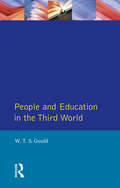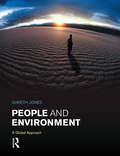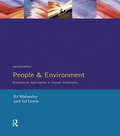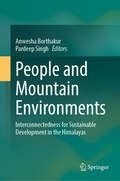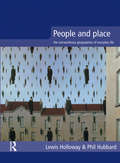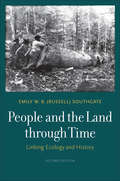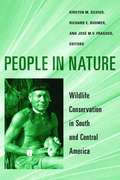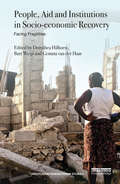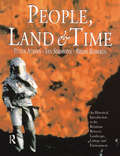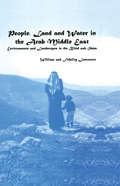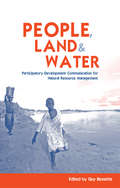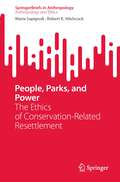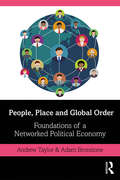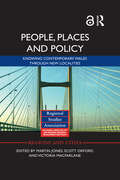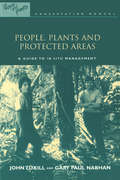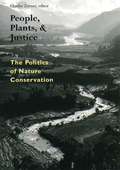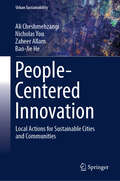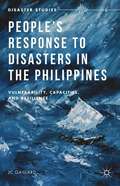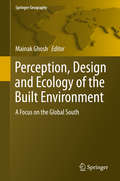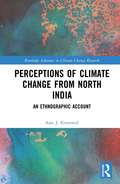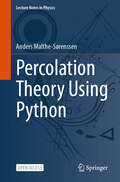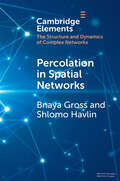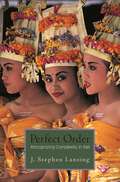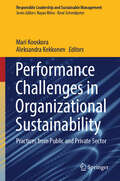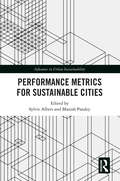- Table View
- List View
People and Education in the Third World (Longman Development Studies)
by W. T. GouldFirst published in 1993. Routledge is an imprint of Taylor & Francis, an informa company.
People and Environment: A Global Approach
by Gareth JonesPeople and Physical Environment, A Global Approach provides an introduction to the main areas of environmental concern for geographers, environmental scientists and planners at the beginning of the twenty-first century. These include:Pollution of the atmosphere and its impact on our climate; The exploitation of the oceans; Management and supply of fresh water; Degradation of the land, and Biodiversity, and the need to maintain genetic diversity.The book argues that our knowledge and understanding of the environment is now so great that we can predict with considerable accuracy where the skills of science and technology need to be focussed in order to prevent severe environmental damage from occurring. Achieving successful management of the environment has become dependent upon active participation of a society prepared to pay for a high quality of life and the willingness of our elected politicians to legislate and enforce the very highest standards of environmental management. This book will be essential reading for students of geography, environmental studies/science and land use planners and will also contribute valuable information for climatology, biogeography, hydrology, land economy and forestry students.
People and Environment: Behavioural Approaches in Human Geography
by D. J. Walmsley G. J. LewisFirst published in 1994. Routledge is an imprint of Taylor & Francis, an informa company.
People and Mountain Environments: Interconnectedness for Sustainable Development in the Himalayas
by Pardeep Singh Anwesha BorthakurPeople living in the mountains maintain a unique relationship with their surrounding environment. Humans have settled in mountainous regions all across the globe for centuries, adapting to the challenging terrains and establishing exceptional cultural practices and lifestyles. Until today, they depend on their immediate ecosystems for their everyday necessities while also conserving those environments through their own traditional practices and belief systems. Understanding and addressing the ease and complexities of the relationship between people and mountains is essential for sustainable development through overall conservation and well-being of both the environment and the communities living in these regions. The mountain communities in the Himalayas and their interconnectedness with their surroundings could provide important insights in this regard. For instance, the interaction between humans and mountains in the Himalayas is diverse, spanning across various cultural, economic, political, environmental and recreational dimensions and parameters. As sustainable development is a core goal of the world today, it is both interesting and pertinent to explore these various aspects and locate possible learnings in the present-day global environmental scenario. Accordingly, this book is an attempt to situate the interconnected between people and the mountains in the Himalayan landscape towards tracing learnings for sustainable development. Our aim is to edit a holistic volume where aspects ranging from ecosystem services to cultural and spiritual significances of the mountains for the local communities and from contributions of the Himalayas in relation to water, agriculture and food practices to the challenges associated with haphazard infrastructural developments and environmental justice implications are adequately addressed. We acknowledge that balancing the human needs of the mountain communities while ensuring environmental conservation is a major challenge. Ecologically fragile and biodiversity rich the Himalayan region is no exception. Further, mountain communities in the Himalayas are facing tremendous challenges in adapting to changing climate conditions, such as altered precipitation patterns and increased frequency of extreme weather events. Unsustainable economic activities in the form of chaotic tourism practices and infrastructural developments among others add to the emerging challenges. Accordingly, it is important to put research efforts towards active sustainable development practices where human needs are met while minimizing undesirable impacts on the Himalayan mountain ecosystems. The Himalayas are critical for global ecological balance. Therefore, this book will not only be helpful for the countries situated in these mountain regions alone, but also will provide useful insights for environmental sustainability at a much larger global scale.
People and Place: The Extraordinary Geographies of Everyday Life
by Phil Hubbard Lewis HollowayAn innovative introduction to Human Geography, exploring different ways of studying the relationships between people and place, and putting people at the centre of human geography. The book covers behavioural, humanistic and cultural traditions, showing how these can lead to a nuanced understanding of how we relate to our surroundings on a day-to-day basis. The authors also explore how human geography is currently influenced by 'postmodern' ideas stressing difference and diversity. While taking the importance of these different approaches seriously as ways of thinking about the role of place in peoples' everyday lives, the book also tries to encapsulate what has been so vibrant and exciting about human geography over the last couple of decades. By using examples to which students can relate - such as how they imagine and represent their home, the way they avoid certain spaces, how they move through retail spaces, where they choose to go to university, how they use the Internet, how they represent other nations and so on - the authors show how geography shapes everyday life in a manner that is seemingly mundane yet profoundly important.
People and the Land through Time: Linking Ecology and History, Second Edition
by Emily W. SouthgateA revised and updated edition of a classic book that defines the field of historical ecologyPeople and the Land through Time, first published in 1997, remains the only introduction to the field of historical ecology from the perspective of ecology and ecosystem processes. Widely praised for its emphasis on the integration of historical information into scientific analyses, it will be useful to an interdisciplinary audience of students and professionals in ecology, conservation, history, archaeology, geography, and anthropology. This up-to-date second edition addresses current issues in historical ecology such as the proposed geological epoch, the Anthropocene; historical species dispersal and extinction; the impacts of past climatic fluctuations; and trends in sustainability and conservation.
People in Nature: Wildlife Conservation in South and Central America
by Kirsten Silvius Richard Bodmer José FragosoThis book reviews wildlife management and conservation in Central and South America. The book discusses the threats to biodiversity in this area including habitat fragmentation, development, ranching, tourism as well as hunting. The book contains contributions from many local Latin American authors who work there daily and are exposed to the numerous and unique issues that need to be taken into account when talking about conservation in Central and South America.
People, Aid and Institutions in Socio-economic Recovery: Facing Fragilities (Routledge Humanitarian Studies)
by Bart Weijs Dorothea Hilhorst Gemma Van Der HaarAn estimated 2 billion people live in countries affected by fragility, conflict and violence. Extreme poverty is increasingly concentrated in these areas, and governments and international agencies seek avenues to enable socio-economic recovery and to support people as they try to rebuild their lives and livelihoods. People, Aid and Institutions in Socio-economic Recovery: Facing Fragilities provides an in-depth understanding of people’s strategies in the face of conflict and disaster-related fragility and examines how policies and aid interventions enable their socio-economic recovery – or fail to do so. Through field-based research, the book captures the complex and unfolding realities on the ground, exploring the interfaces between economic, social and institutional change. This provides a rich and unique vantage point from which to reflect on the impact of recovery policies. The book provides a set of cross-cutting findings that aim to inform policy and practice. The detailed case studies of the book lay bare key dynamics of recovery. Set against the findings from two chapters that review the literature, the cases provide evidence-based lessons for socio-economic recovery. The chapters combine qualitative and quantitative methodologies and form a valuable resource to researchers and postgraduate students of disaster management, conflict, humanitarian aid and social reconstruction, and development management.
People, Land and Time: An Historical Introduction to the Relations Between Landscape, Culture and Environment
by Ian Simmons Brian Roberts Peter AtkinsThis major new text provides an introduction to the interaction of culture and society with the landscape and environment. It offers a broad-based view of this theme by drawing upon the varied traditions of landscape interpretation, from the traditional cultural geography of scholars such as Carl Sauer to the 'new' cultural geography which has emerged in the 1990s. The book comprises three major, interwoven strands. First, fundamental factors such as environmental change and population pressure are addressed in order to sketch the contextual variables of landscapes production. Second, the evolution of the humanised landscape is discussed in terms of processes such as clearing wood, the impact of agriculture, the creation of urban-industrial complexes, and is also treated in historical periods such as the pre-industrial, the modern and the post-modern. From this we can see the cultural and economic signatures of human societies at different times and places. Finally, examples of landscape types are selected in order to illustrate the ways in which landscape both represents and participates in social change.The authors use a wide range of source material, ranging from place-names and pollen diagrams to literature and heritage monuments. Superbly illustrated throughout, it is essential reading for first-year undergraduates studying historical geography, human geography, cultural geography or landscape history.
People, Land and Water in the Arab Middle East: Environments and Landscapes in the Bilad ash-Sham (Studies in Environmental Anthropology #Vol. 2)
by Fidelity LancasterThe result of twenty-five years of research with different tribal groups in the Arabian peninsula, this study focuses on ethnographic descriptions of Arab tribal societies in five regions of the peninsula, with comparative material from others. Having become aware of the depth in time of Arab tribal structures, the authors have developed a view of Arabic tribal discourse where 'tribe' is seen as essentially an identity that confers access to a social structure and its processes.
People, Land and Water: Participatory Development Communication for Natural Resource Management
by Guy BessetteIn natural resource management research, best practice implies the participation of community members, research or development teams and other stakeholders to jointly identify research and development parameters and contribute to decision making. Ideally, the research or development process itself generates a situation of empowerment in which participants transform their vision and become able to take effective action. Used increasingly widely in resource management, this process is known as Participatory Development Communication (PDC). This book presents conceptual and methodological issues related to the use of PDC to facilitate participation amongst stakeholders in a variety of natural resource management initiatives. Each chapter presents in-depth experiences from Asia and Africa to highlight different ways in which this process can be achieved. The book describes the major issues involved in applying PDC to natural resource management practices and research, discusses the challenges and the difficulties linked to such an approach and offers insights and lessons from research and experience in the field.
People, Parks, and Power: The Ethics of Conservation-Related Resettlement (SpringerBriefs in Anthropology)
by Robert K. Hitchcock Maria SapignoliThis book presents a critical review of the ethics of conservation-related resettlement. We examine what has become known as the” parks versus people” debate, also known as the “new conservation debate,” which has pitted indigenous and other local people against nation states and social scientists against ecologists and conservationists for the past several decades. Aiming to promote biodiversity conservation and habitat preservation, some biologists, park planners, and conservation organizations have recommended that indigenous and other people should be removed from protected areas. Local people, for their part, have argued that residents of the areas that were turned into protected areas, national parks, game reserves and monuments had managed them in productive ways for generations and that they should have the right to remain there and to use natural resources as long as they do so sustainably. This position is often supported by indigenous rights organizations and social scientists, especially anthropologists. There are also some conservation-oriented NGOs that have policies involving a more human rights-oriented approach aimed at poverty alleviation, sustainable development, and social justice. The book discusses biodiversity conservation, indigenous peoples (those who are ethnic minorities and who are often marginalized politically), and protected areas, those categories of land set aside by nation-states that have various kinds of rules about land use and residence. The focus initially is on case studies from protected areas in the United States including Yellowstone National Park, Yosemite National Park, and Glacier National Park and on national monuments and historical parks where resettlement took place. We then consider issues of coercive conservation in southern Africa, including Hwange National Park (Zimbabwe), the Central Kalahari Game Reserve (Botswana), Etosha National Park, and Bwabwata National Park (Namibia), and Kgalagadi Transfrontier Park (South Africa and Botswana). All of these cases involved involuntary resettlement at the hands of the governments. In the book we consider some of the social impacts of conservation-forced resettlement (CfR), many of which tend to be negative. After that, we assess some of the strategies employed by indigenous peoples in their efforts to recover rights of access to protected areas and the cultural and natural resources that they contain. Examples are drawn from cases in Asia, Africa, and South America. Conclusions are provided regarding the ethics of conservation-related resettlement and some of the best practices that could be followed, particularly with regard to indigenous peoples.
People, Place and Global Order: Foundations of a Networked Political Economy
by Andrew Taylor Adam BronstoneGlobalization and technology are combining to change socio-economic relationships. The pace of change and uncertainty of the world of work – no job for life, zero-hours contracts, diminished pension rights and a growing delivery dependence on digital networks over human contact – are creating a profound unease that may be unprecedented in the Western world. If organizational patterns are not sufficiently adjusted and businesses continue as usual, we run the risk of alienating entire groups within society with many feeling ‘left behind’. Using deliberately accessible language for students and the general reader, the authors draw upon socially innovative models of economic organization from the nineteenth century to present a model to master this new economy for the common good. The book illustrates, with practical examples, how digital networks can be leveraged and provides a common checklist to identify suitable conditions for organizations to flourish and provide the means to more effectively evaluate opportunities.
People, Places and Policy: Knowing contemporary Wales through new localities (Regions and Cities)
by Martin Jones Scott Orford Victoria MacfarlaneThe Open Access version of this book, available at www.tandfebooks.com, has been made available under a Creative Commons Attribution-Non Commercial-No Derivatives 3.0 license. Set within the context of UK devolution and constitutional change, People, Places and Policy offers important and interesting insights into ‘place-making’ and ‘locality-making’ in contemporary Wales. Combining policy research with policy-maker and stakeholder interviews at various spatial scales (local, regional, national), it examines the historical processes and working practices that have produced the complex political geography of Wales. This book looks at the economic, social and political geographies of Wales, which in the context of devolution and public service governance are hotly debated. It offers a novel ‘new localities’ theoretical framework for capturing the dynamics of locality-making, to go beyond the obsession with boundaries and coterminous geographies expressed by policy-makers and politicians. Three localities – Heads of the Valleys (north of Cardiff), central and west coast regions (Ceredigion, Pembrokeshire and the former district of Montgomeryshire in Powys) and the A55 corridor (from Wrexham to Holyhead) – are discussed in detail to illustrate this and also reveal the geographical tensions of devolution in contemporary Wales. This book is an original statement on the making of contemporary Wales from the Wales Institute of Social and Economic Research, Data and Methods (WISERD) researchers. It deploys a novel ‘new localities’ theoretical framework and innovative mapping techniques to represent spatial patterns in data. This allows the timely uncovering of both unbounded and fuzzy relational policy geographies, and the more bounded administrative concerns, which come together to produce and reproduce over time Wales’ regional geography.
People, Plants and Protected Areas: A Guide to in Situ Management (People and Plants International Conservation #Vol. 3)
by Gary Paul Nabhan John Tuxill with Elizabeth Drexler Michael HathawayConservation of plant resources is often focused on seed banks and botanical gardens. However, the two authors of this volume present a comprehensive conservation strategy that complements this ex-situ approach with practical guidance on in-situ management and conservation of plant resources. The book aims to facilitate better management of protected areas and to illustrate new approaches to conservation of plants within their landscapes. It draws on concepts from forestry, the agricultural sciences, anthropology, ethnology and ethnobotany and should be useful to practitioners, academics and policy-makers.
People, Plants, and Justice: The Politics of Nature Conservation
by Charles ZernerIn an era of market triumphalism, this book probes the social and environmental consequences of market-linked nature conservation schemes. Rather than supporting a new anti-market orthodoxy, Charles Zerner and colleagues assert that there is no universal entity, "the market." Analysis and remedies must be based on broader considerations of history, culture, and geography in order to establish meaningful and lasting changes in policy and practice.Original case studies from Asia, Latin America, Africa, and the South Pacific focus on topics as diverse as ecotourism, bioprospecting, oil extraction, cyanide fishing, timber extraction, and property rights. The cases position concerns about biodiversity conservation and resource management within social justice and legal perspectives, providing new insights for students, scholars, policy professionals and donor/foundations engaged in international conservation and social justice.
People-Centered Innovation: Local Actions for Sustainable Cities and Communities (Urban Sustainability)
by Ali Cheshmehzangi Zaheer Allam Bao-Jie He Nicholas YouAs a follow-up to the book titled &“Harnessing Urban Innovation to Unlock the Sustainable Development Goals&”, this collection examines transformative urban solutions through 15 internationally recognized case studies submitted to the 6th Guangzhou International Award for Urban Innovation in 2023. It provides valuable insights into the driving forces behind sustainable urban development, aligning closely with the United Nations' Sustainable Development Goals (SDGs). The main focus of the book is on people-centered approaches to urban innovation, demonstrating how grassroots initiatives can tackle complex urban challenges and contribute to global sustainability targets. Each case study presents innovative strategies implemented by communities worldwide, showcasing how local actions can greatly impact sustainability and resilience. The varied examples highlight a spectrum of urban issues, including affordable housing, sustainable transportation, climate adaptation, and social inclusion, reflecting the diverse nature of urban innovation. Key Features and Benefits: Varied Global Case Studies: The book includes fifteen case studies from different regions, each presenting unique solutions to urban challenges. These examples illustrate how various cultures and contexts address common problems, providing a rich array of ideas and practices. This makes it an essential resource for urban planners, policymakers, and community leaders seeking inspiration and guidance. Emphasis on People-Centered Approaches: The book emphasizes the importance of people-centered innovation, which prioritizes community involvement and local knowledge. By focusing on how local populations engage with and drive urban initiatives, the book highlights the significance of inclusivity and participatory processes in achieving sustainable outcomes. Alignment with the SDGs: Each case study is connected to specific Sustainable Development Goals, demonstrating how local actions contribute to global sustainability objectives. The book illustrates how grassroots initiatives address key areas such as poverty reduction, climate action, and sustainable cities and communities, highlighting the critical role of local efforts in achieving the broader SDG agenda.
People’s Response to Disasters in the Philippines: Vulnerability, Capacities, and Resilience (Disaster Studies)
by Jc GaillardThis book provides a critical perspective on people's response to disasters in the Philippines. It draws upon an array of case studies to discuss people's vulnerability, capacities and resilience in facing a wide range of different hazards.
Perception, Design and Ecology of the Built Environment: A Focus on the Global South (Springer Geography)
by Mainak GhoshThis edited volume is a compilation of the ‘built environment’ in response to many investigations, analyses and sometimes mere observations of the various dialogues and interactions of the built, in context to its ecology, perception and design. The chapters concentrate on various independent issues, integrated as a holistic approach, both in terms of theoretical perspectives and practical approaches, predominantly focusing on the Global South. The book builds fabric knitting into the generic understanding of environment, perception and design encompassing ‘different’ attitudes and inspirations. This book is an important reference to topics concerning urbanism, urban developments and physical growth, and highlights new methodologies and practices. The book presumes an understanding unearthed from various dimensions and again woven back to a common theme, which emerges as the reader reads through.Various international experts of the respective fields working on the Global South contributed their latest research and insights to the different parts of the book. This trans-disciplinary volume appeals to scientists, students and professionals in the fields of architecture, geography, planning, environmental sciences and many more.
Perceptions of Climate Change from North India: An Ethnographic Account (Routledge Advances in Climate Change Research)
by Aase J. KvanneidPerceptions of Climate Change from North India: An Ethnographic Account explores local perceptions of climate change through ethnographic encounters with the men and women who live at the front line of climate change in the lower Himalayas. From data collected over the course of a year in a small village in an eco-sensitive zone in North India, this book presents an ethnographic account of local responses to climate change, resource management and indigenous environmental knowledge. Aase Kvanneid’s observations cast light on the precarious reality of climate change in this region and bring to the fore issues such as access to water, NGO intervention and climate information for farmers. In doing so, she also explores classic topics in the study of rural India including ritual, gender, social hierarchy and political economy. Overall, this book shows how the cause and effect of climate change is perceived by those who have the most to lose and explores how the impact of climate change is being dealt with on a local and global scale. This book will be of great interest to students and scholars of the anthropology of climate change, environmental sociology and rural development.
Percolation Theory Using Python (Lecture Notes in Physics #1029)
by Anders Malthe-SørenssenThis course-based open access textbook delves into percolation theory, examining the physical properties of random media—materials characterized by varying sizes of holes and pores. The focus is on both the mathematical foundations and the computational and statistical methods used in this field. Designed as a practical introduction, the book places particular emphasis on providing a comprehensive set of computational tools necessary for studying percolation theory. Readers will learn how to generate, analyze, and comprehend data and models, with detailed theoretical discussions complemented by accessible computer codes. The book's structure ensures a complete exploration of worked examples, encompassing theory, modeling, implementation, analysis, and the resulting connections between theory and analysis. Beginning with a simplified model system—a model porous medium—whose mathematical theory is well-established, the book subsequently applies the same framework to realistic random systems. Key topics covered include one- and infinite-dimensional percolation, clusters, scaling theory, diffusion in disordered media, and dynamic processes. Aimed at graduate students and researchers, this textbook serves as a foundational resource for understanding essential concepts in modern statistical physics, such as disorder, scaling, and fractal geometry.
Percolation in Spatial Networks: Spatial Network Models Beyond Nearest Neighbours Structures (Elements in Structure and Dynamics of Complex Networks)
by Shlomo Havlin Bnaya GrossPercolation theory is a well studied process utilized by networks theory to understand the resilience of networks under random or targeted attacks. Despite their importance, spatial networks have been less studied under the percolation process compared to the extensively studied non-spatial networks. In this Element, the authors will discuss the developments and challenges in the study of percolation in spatial networks ranging from the classical nearest neighbors lattice structures, through more generalized spatial structures such as networks with a distribution of edge lengths or community structure, and up to spatial networks of networks.
Perfect Order: Recognizing Complexity in Bali (Princeton Studies in Complexity #11)
by J. Stephen LansingAlong rivers in Bali, small groups of farmers meet regularly in water temples to manage their irrigation systems. They have done so for a thousand years. Over the centuries, water temple networks have expanded to manage the ecology of rice terraces at the scale of whole watersheds. Although each group focuses on its own problems, a global solution nonetheless emerges that optimizes irrigation flows for everyone. Did someone have to design Bali's water temple networks, or could they have emerged from a self-organizing process? Perfect Order--a groundbreaking work at the nexus of conservation, complexity theory, and anthropology--describes a series of fieldwork projects triggered by this question, ranging from the archaeology of the water temples to their ecological functions and their place in Balinese cosmology. Stephen Lansing shows that the temple networks are fragile, vulnerable to the cross-currents produced by competition among male descent groups. But the feminine rites of water temples mirror the farmers' awareness that when they act in unison, small miracles of order occur regularly, as the jewel-like perfection of the rice terraces produces general prosperity. Much of this is barely visible from within the horizons of Western social theory. The fruit of a decade of multidisciplinary research, this absorbing book shows that even as researchers probe the foundations of cooperation in the water temple networks, the very existence of the traditional farming techniques they represent is threatened by large-scale development projects.
Performance Challenges in Organizational Sustainability: Practices from Public and Private Sector (Responsible Leadership and Sustainable Management)
by Mari Kooskora Aleksandra KekkonenThis book conceptualizes and clarifies the meaning of sustainable performance, approaching it holistically from different perspectives. It focuses on challenges related to movements to transform the world economy into more modern, resource-efficient, and competitive, while keeping in mind harmonization of environmental, social, and governance objectives. This has brought along new initiatives and undertakings that invite people, communities, and organizations to participate in building greener and more sustainable future. The book discusses the UN Sustainable Development Goals (SDGs), EU Green Deal and Climate Pact, and Environmental, Social and Governance (ESG) metrics. It tackles policies and strategies that integrate sustainable practices into business activities to align with these goals, focusing on the increasing number of regulations, such as ESG Reporting, Sustainable Finance Disclosure Regulation (SFDR), Corporate Sustainability Reporting Directive (CSRD), and Green Taxonomy. The book highlights new challenges organizations will face as they navigate their way through these goals and regulations, and provides practical coping tips. It is divided into four main parts which consecutively discuss and analyze the concepts and approaches more generally in the first part, challenges, approaches, and metrics on green and sustainable performance on regional and local level in the second part; and on companies' level in the third part; and how top-down (public sector) and bottom-up (private sector) approaches meet. Finally, in the fourth part, the book showcases concrete cases and best practices related to the above-described topics showing how the challenges related to green and sustainable performance have been turned to new opportunities and competitive advantage in different organizations in different industries. The book is a valuable resource for not only academia, researchers, master, and doctoral level students (especially in the sustainability courses), and executive trainings, but also practitioners, politicians, public officials, and organizational leaders interested in turning their organizations into more sustainable units.
Performance Metrics for Sustainable Cities (Advances in Urban Sustainability)
by SylvieManish Albert PandeyPerformance Metrics for Sustainable Cities provides an overview of measurement systems and tools to enable communities to self-assess and benchmark their progress along a continuum of smart, intelligent, and sustainable development. It begins by explaining the importance of measurement and evaluation for cities and smaller communities, as well as future factors that will need to be considered and embedded into planning processes. Across 14 chapters, the book describes existing evaluation mechanisms that are being used for government funding decisions, awards of recognition, and new measurement systems to assess what makes a city smarter and more sustainable, such as broader sustainable goal targets (UN SDGs), green cities, fabrication cities, and compassionate cities. It presents examples of metrics used for important sustainability and liveability concepts for cities such as how to measure trust, engagement, compassion, circular economy, and so forth. The book ends with reflections on the feasibility of a holistic system of measurement and the implications of its implementation. This volume will be of great interest to students, researchers, and professionals of urban sustainability, planning, smart cities, and sustainable communities.
